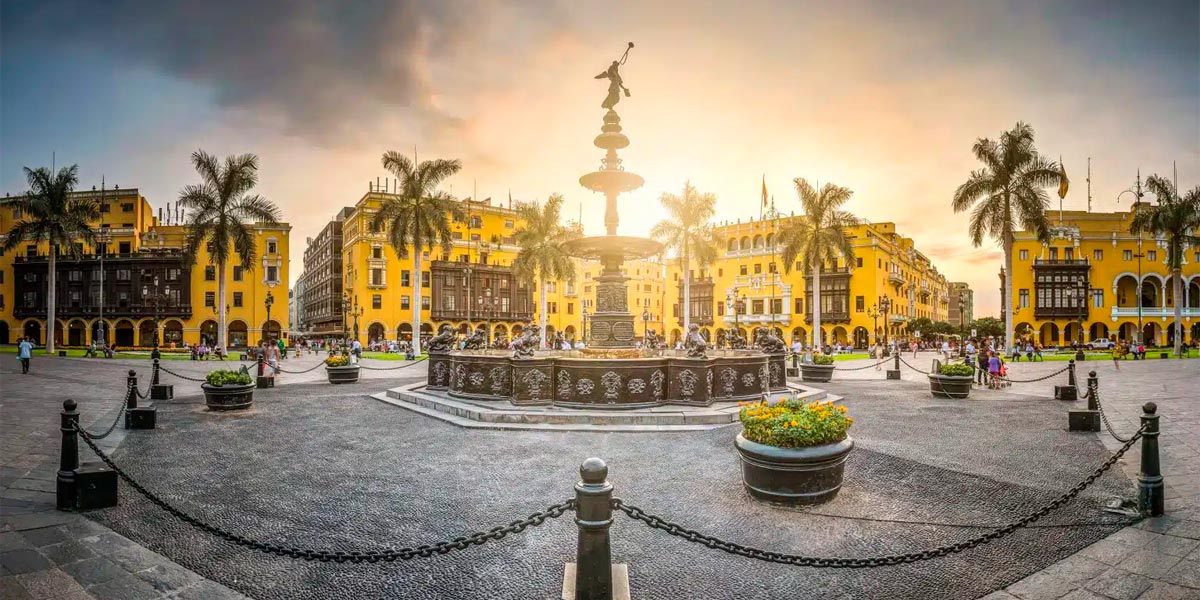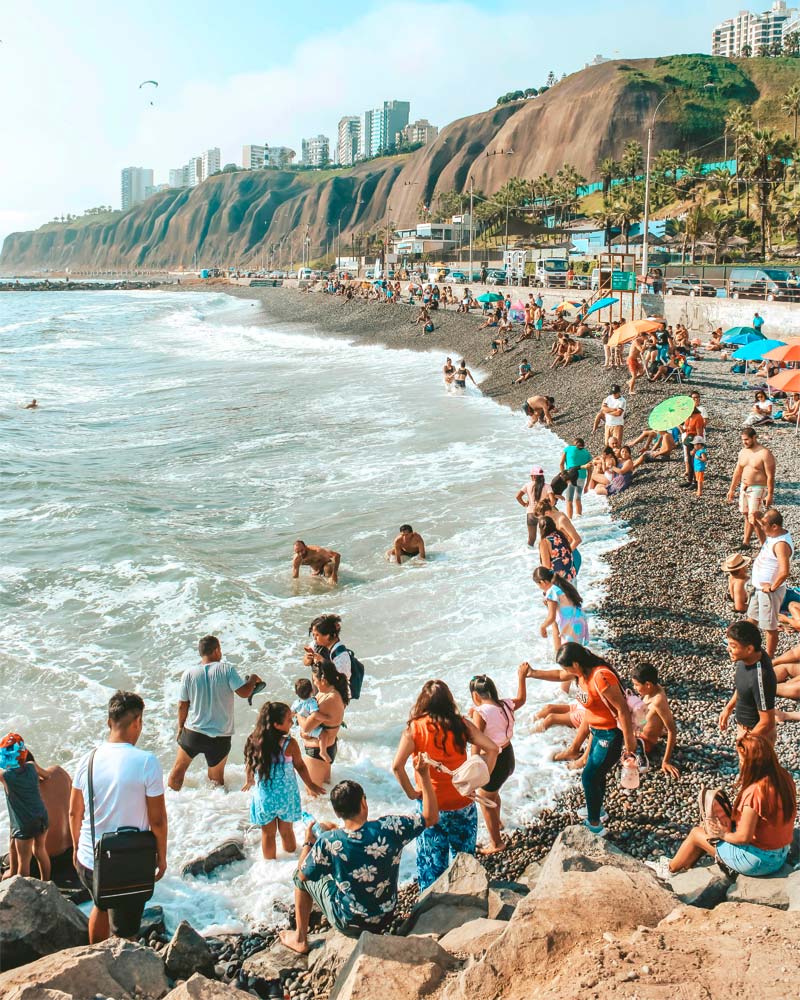
Most people know that the capital of Peru is Lima, but what many don't know is that its history is as vast as it is fascinating. Over the centuries, it has gone from being an Inca settlement to becoming a colonial city and, finally, a modern metropolis.
Lima, traditionally known as "The City of Kings", is the largest and most populated city in the country. Located on the Pacific Ocean coast, it has more than nine million inhabitants and concentrates a large part of Peru's economic and financial activity.
Today, Lima is full of modernity and tradition, its districts show contrasts between contemporary architecture and colonial remains, while its location makes it the starting point to explore iconic destinations like Cusco, Arequipa, or the Amazon.
Where is Peru located?
The Republic of Peru is located on the west coast of South America. It borders Ecuador and Colombia to the north; Brazil to the east; Bolivia to the southeast; Chile to the south; and the Pacific Ocean to the west.
The country stands out for its impressive biodiversity: from the arid coastal plains of the Pacific, through the imposing peaks of the Andes, to the vast Amazon rainforest. Peru is the nineteenth largest country in the world and the third most extensive in South America. In its territory, ancient civilizations flourished, such as Caral, Mochica, Nazca, Chimú, and, of course, the powerful Inca Empire. Each one left important capitals and urban centers that today are part of the Peruvian cultural legacy. Currently, Peru is a multicultural country with a great diversity of languages, traditions, and ethnicities.

Historically, the most important cities in the country have been Cusco and Lima. Cusco, the capital of the Inca Empire from the 14th to the 16th century, was the center of the Tawantinsuyo (the four regions of the sun), a vast territory that extended through what is now Colombia, Ecuador, Peru, Bolivia, Argentina, and northern Chile. Recognized as the historical capital of Peru, Cusco was the most relevant city in South America in its time.
After the arrival of the Spanish conquerors, the capital was moved to Lima. Founded on January 18, 1535, by Francisco Pizarro with the name City of the Kings, its name was inspired by the festival of the Epiphany. Over time, the name Lima was adopted, and the city was consolidated as the main political, economic and cultural center of the country.
Important Fact: Currently, the
Historic Center of Lima is a UNESCO World Cultural Heritage site since 1988, thanks to its valuable colonial architecture and its historical monuments.
Where is the capital of Peru?
Lima, the capital of Peru, is located at an elevation of 528 feet (161 meters) in the central-western part of Peru. The city center is located about 8 miles (13 km) inland from the Pacific Ocean in the coastal desert of Peru.
While the “City of Kings” was initially founded on the banks of the Rimac River, today it spans vast desert areas from north to south, including 11 rivers and many valleys. The city of Lima has grown so rapidly in the 1980s and 1990s due to immigration from the countryside and terrorism.
Today Lima is considered the fifth largest city in South America and the Caribbean countries, including Mexico.
History of Lima – Peru
- Initially, Lima was occupied by small civilizations from the coastal area of Peru; by the 15th century, the Inca Empire dominated the entire region.
- In 1532, the Inca king Atahualpa was captured in Cajamarca by the Spanish conquistadors led by Francisco Pizarro.
- In April 1534, Francisco Pizarro founded the first Peru capital in Jauja, a city located in the Andes with a warm and pleasant climate.
- In December 1534, Francisco Pizarro ordered the transfer of all the treasures of Jauja to Lima, a city located near the sea and the main port of Callao.
- On January 18, 1533, Francisco Pizarro established the city of Lima (City of Kings) as the new capital of the Colony.
- On May 6, 1536, the Manco Inca Rebellion began. He sent Captain Quizo Yupanqui with his troops to besiege Lima. In September, the Inca troops arrived in Lima, where Captain Quizo Yupanqui was killed, and the Inca army retreated to the mountains.
- Francisco Pizarro was killed on June 26, 1541 by a group of people called the Almagristas. They were led by Diego de Almagro el Mozo.
- On November 4, 1780, Tupac Amaru II (José Gabriel Condorcanqui) started the revolution in the Tinta Province in Cusco. He was executed in the Plaza del Cusco on July 19, 1783.
- On July 28, 1821, General José de San Martín proclaimed the famous Declaration of Independence in the Plaza Mayor of Lima.
- On January 17, 1881, Lima was occupied by the Chilean army during the War of the Pacific. Finally, on October 20, 1883, Peru and Chile signed the Treaty of Ancón; Peru ceded the province of Tarapacá to Chile. Antofagasta was forced to surrender by Bolivia
- Lima hosted the 2019 Pan American Games, which were the largest sporting event the country has ever seen.

Frequently Asked Questions about Lima – Peru
What is the Location of Lima?
Lima, the capital of Peru, is located in the central part of the Pacific coast, flanked by coastal deserts, and extends to the valleys of the Chillón, Rimac, and Lurín rivers. It covers an area of 2,672 km2 (1,031 sq mi).What is the average altitude of the city of Lima?
Lima is a city at sea level; the average altitude of the historic city center is 528 feet (161 meters).What is the predominant religion in Lima?
The dominant religion is Christianity. However, Peru is traditionally associated with religious fusion, originating from Catholicism and the ancient Incan religion after the Spanish conquest. It is also becoming common for Judaism, Buddhism, Hinduism, and Islam due to immigration in recent years.What is the climate of Lima?
Although Lima is in the tropics and the desert, it has a temperate climate because it is close to the Pacific Ocean.
During the summer, from December to April, the daily temperature ranges from 18°C (64°F) to 22°C (72°F) and from 24°C (75°F) to 29°C (84°F). During this time of year, the days are sunny and warm.
During the winter, from June to October, temperatures range from 14°C (57°F) to 16°C (61°F), with the minimum being 14°C (57°F) and the maximum being 16°C (61°F) to 19°C (66°F). The sky is usually grey during this time, with morning drizzle and high humidity.
May and November are transitional months where we see sudden changes in the weather.What is the main currency in Lima?
The main currency in Peru is Nuevos Soles; in most local markets and shops, you will use only Soles. However, banks will allow you to make transactions in Soles or USD. Car, house and real estate transactions are always made in USD.What is the main population of Lima?
The population of Lima is made up of several ethnic groups. The largest groups are mestizos, Europeans (descendants of Spanish, German, Italian and French), Afro-Peruvians and Asians (China and Japan).
Thanks to this complex mix of racial and ethnic groups, Peru is now one of the best culinary destinations in the world. Chinese and Italian cuisine has helped create unique Peruvian dishes.What is the official language of Lima, Peru?
The official languages of Peru are Spanish, Quechua, and Aymara!
 |  |
How to get to Lima?
By Land: The Pan-American Highway runs through the country from south to north, connecting with all the cities in the coastal area and other countries such as Chile in the south and Ecuador in the north. We also have access to highways in the east that connect us with the cities of the Andes and the jungle of Peru.
By Air: From Peru's Jorge Chavez International Airport, located in the province of Callao, 30 minutes from downtown Lima. You can take flights to any city in Peru or any other country.
The best way to travel from Lima to Cusco
The best and fastest way to travel from Lima to Cusco and vice versa is by taking a flight from Jorge Chavez Airport in Lima to Alejandro Velasco Astete Cusco. The duration is approximately 1 hour of flight.
For travelers who like to explore the country more, they can take a bus from Lima via Abancay to Cusco with a duration of 20 hours. Also, take a bus from Lima via Arequipa to Juliaca with a bus ride of 24 hours.
The best trips in Peru
Peru offers unique experiences that show impressive landscapes, archaeological sites, and living traditions, attracting travelers who seek adventure and discovery in each region of the country. Get to know some of the most recommended trips to explore its diversity.
Inca Trail, Machu Picchu and more


